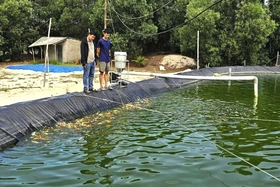{title}
{publish}
{head}
Quang Tri province has a long and beautiful coastline, offering favorable conditions for developing coastal tourism. However, in reality, the province’s coastal tourism remains largely untapped, with a lack of quality services leading to short visitor stays and limited revenue from beach tourism. To effectively develop coastal tourism in Quang Tri, there is a need for appropriate, long-term, and sustainable solutions.

The Gio Hai Service and Tourism Area project in Gio Linh district is gradually being completed, contributing to the development of coastal tourism. Photo: Tu Linh
Quang Tri province boasts a long and beautiful coastline, providing excellent conditions for coastal tourism development. In recent years, the province has invested in infrastructure at several coastal tourist spots to boost the area’s growth. In Gio Linh district, the infrastructure development project for inclusive growth in the Greater Mekong Subregion, specifically Quang Tri’s subproject, is nearing completion. This will help enhance the tourism infrastructure at Trung Giang, Gio Hai, and Cua Viet beaches.
Currently, the transportation infrastructure supporting economic growth and promoting coastal tourism has been significantly upgraded. Accommodations in the coastal towns of Cua Tung and Cua Viet are gradually being developed. In Gio Hai commune and Cua Viet town, large-scale tourism zones are being completed. To date, Quang Tri’s coastal areas have more than 50 accommodation facilities, providing a substantial number of rooms for tourists. Despite these efforts, the number of visitors remains small compared to the potential and advantages the province possesses.
Nguyen Duc Tan, Director of the Investment, Trade, and Tourism Promotion Center, noted that despite its potential, Quang Tri’s coastal tourism has not yet fully developed and faces many limitations. Tourism services remain underdeveloped; modern accommodations are still scarce, and coastal tourism products lack diversity. Infrastructure at many beaches is still incomplete, and there is no dedicated port capable of receiving large international cruise ships.
Marine tourism and services are key sectors identified in the Central Party Committee’s Resolution No. 36-NQ/TW, issued on December 22, 2018, on the “Strategy for Sustainable Development of Vietnam’s Marine Economy until 2030, with a Vision to 2045.” Coastal tourism has also been recognized as one of Vietnam’s four main tourism products, highlighted in the Prime Minister’s Decision No. 147/QD-TTg dated January 22, 2020, approving the Vietnam Tourism Development Strategy until 2030.
Nguyen Duc Tan further emphasized that while there are policies in place to promote coastal tourism as a means to create jobs and boost local economies, coastal areas need to adopt more proactive approaches to attract tourists instead of passively waiting for them to arrive.
To develop coastal tourism in line with its potential and establish a unique brand, the province must accelerate investment in coastal tourism projects to improve tourism services. Effective investment and management in infrastructure, services, and human resources are essential. Localities should also focus on upgrading technical standards, hygiene, and safety to enhance visitor experiences.
A particular focus should be on synchronized transportation infrastructure, connecting coastal towns to improve accessibility from the sea. The construction of Quang Tri Airport should be expedited to shorten travel time for visitors and boost connections with Con Co Island. Moreover, the creation of mechanisms and the enhancement of tourism services on Con Co Island are necessary. Travel companies should develop new, diverse tourism products for coastal visitors, offering unique and appealing tour packages.
Efforts should also continue in promoting Quang Tri’s coastal destinations to tourists from Laos and northeastern Thailand. Along with this, improving tourism services, cuisine, and cultural experiences will help attract both domestic and international visitors. Communication and marketing efforts should be expanded across multiple channels to reach a wider audience.
In the long term, Nguyen Duc Tan suggested developing distinctive coastal tourism products. One potential idea is to establish a maritime cultural museum in Cua Viet town, showcasing valuable documents and images related to the protection and development of Vietnam’s seas and islands throughout history. The museum would also honor the marine cultural heritage of Quang Tri’s fishing communities, creating a highlight for coastal tours and educating younger generations on the importance of protecting the nation’s maritime sovereignty. This unique attraction would draw visitors due to its distinctive appeal.
In 2017, the Quang Tri Provincial Party Committee issued Action Program No. 83-CTHD/TU, setting a goal that by 2025, tourism would become a key economic sector, contributing significantly to the province’s economic restructuring and creating a breakthrough for future development. Investing in tourism infrastructure is a key focus to attract more visitors. Quang Tri has a coastline stretching 75 km, with the coastal region covering 16 seaside communes in four coastal districts: Vinh Linh, Gio Linh, Trieu Phong, Hai Lang, and Con Co island district.
The province also has a geographic-economic advantage as a transportation hub at the midpoint of the country, strategically located at the beginning of the East-West Economic Corridor, connecting Laos, Thailand, and Myanmar via the Lao Bao International Border Gate to central Vietnam’s seaports. This provides favorable conditions for Quang Tri to expand regional economic cooperation, trade, international transport, and the development of commerce, services, and tourism.
Quang Tri is focusing on developing tourism from its sea and island resources. With a coastline of 75 km, the province has two important estuaries, Cua Viet and Cua Tung, along with an exclusive economic zone of over 84,000 km2. Its large fishing grounds are rich in valuable marine resources, including rare corals. The estimated seafood reserves in Quang Tri’s waters amount to about 60,000 tons, with an annual harvesting capacity of approximately 17,000 tons.
The coastal region has several sheltered bays, suitable for port development, shipbuilding, repair, and establishing anchoring zones, such as in the Cua Viet and Cua Tung areas. Along the coast, there are beautiful beaches and scenic spots, as well as historical revolutionary sites that are being utilized for tourism, such as the Vinh Moc tunnels and the beaches of Vinh Thai, Cua Tung, Cua Viet, Trieu Lang, and My Thuy. These provide excellent conditions for developing marine ecotourism. Additionally, Quang Tri serves as a connection point for tourism products along the East-West Economic Corridor and the Central Heritage Road. Moreover, people from Laos and Thailand along the East-West Economic Corridor, who do not have access to the sea, have a strong interest in participating in coastal tourism activities.
Tue Linh - Ngoc Mai

QTO - In Quang Tri, clean agricultural stores may not flaunt flashy signs or wide storefronts, but they are quietly becoming trusted places where consumers...

QTO - In a quiet village in central Vietnam, Le Minh Duc, 26, has turned his passion for ornamental fish into a promising startup, the first Koi breeding...